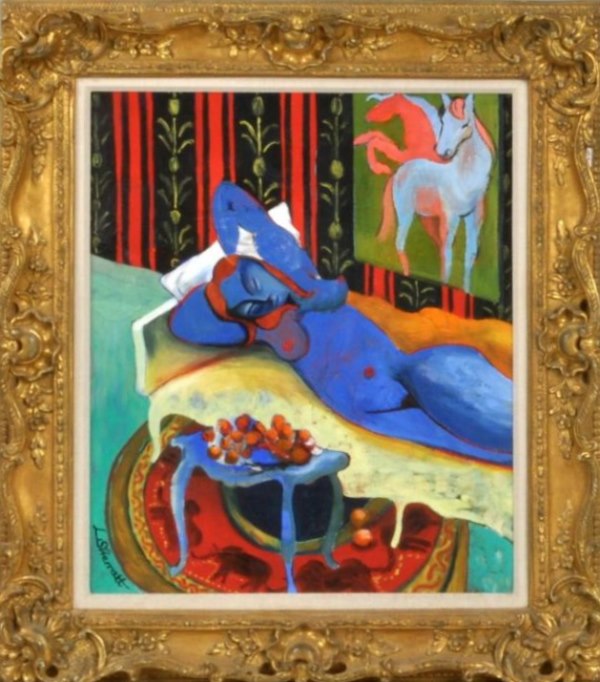
Surrealist Cat Sculpture by Leonora Carrington Expected to Reach $7 Million at Auction

# Leonora Carrington’s “La Grande Dame (The Cat Woman)”: A Surrealist Masterpiece Poised for Auction
Leonora Carrington, one of the most prominent artists of the Surrealist movement, left behind a significant legacy consisting of paintings, writings, and sculptures. Among her most notable pieces, the wooden sculpture titled **”La Grande Dame (The Cat Woman)”** (1951) has emerged on the market this year after nearly 30 years, garnering widespread attention ahead of its auction at [Sotheby’s *Modern Evening Sale*](https://www.sothebys.com/en/buy/auction/2024/modern-evening-auction-2) in New York. The towering sculpture, measuring over 79 inches (about 2 meters) tall, is being lauded as Carrington’s **sculptural magnum opus**, expected to fetch between $5 million and $7 million during its sale on November 18, 2024.
## Carrington’s Surrealistic Legacy
Carrington’s body of work frequently marries the mystical with the feminine, drawing upon cross-cultural folkloric traditions and a deep connection to the subconscious. Her dreamlike, imaginative creations often combine ancient mythologies with personal symbolism, exploring themes of transformation, femininity, mysticism, and magic. A pioneering woman within the male-dominated surrealist movement, Carrington managed to navigate the artistic and literary worlds with remarkable independence, uniquely positioning herself against institutional constraints of her time.
Born in Britain in 1917, Carrington expatriated to Mexico City in 1942, where she spent the rest of her life delving deeper into the mystical environments that informed much of her later work. The themes of transformation, female archetypes, and magic that characterize her oeuvre come into full fruition in *La Grande Dame*, reflecting her expanding worldview as she connected with the rich historical and spiritual landscape of her adopted home.
## *La Grande Dame*: The Cat Woman of Mythical Proportions
**”La Grande Dame”** showcases Carrington’s deep concern with mythology—and the way it intersects with femininity and spirituality—and references the Ancient Egyptian cat goddess **Bastet**. Bastet, known for protecting Egypt from diseases and evil spirits, is also associated with fertility and childbirth, making the symbolism of the figure doubly significant as Carrington often highlighted powerful female deities in her works.
The large wooden sculpture is filled with intricately painted vignettes that tell stories connecting with global folkloric and spiritual traditions. The front and back of the sculpture offer viewers distinct worlds, filled with figures that encapsulate Carrington’s dreamlike imagination. On the figure’s chest, there’s a depiction of a woman with a goose for a head offering an egg to another figure—perhaps nodding to fertility or the exchange of life across realms. Carrington’s references stretch further, incorporating anthropomorphic symbols such as woodland creatures that seem drawn from pre-historic petroglyphic art to animate her tales of transformation and regeneration.
On the back of the figure, further animalistic deities emerge, notably a **wolf-like deity cradling a delicate spirit**, symbolizing protection and connection to nature. This spirit holds a small, glowing seed, while an imposing **dandelion deity** hovers above, reaffirming Carrington’s reverence for nature’s cycles of birth, growth, and death. These scenes radiate a classical surrealism imbued with visions of a world existing on a magical plane, where nature, womanhood, and mystical symbols merge seamlessly.
### Collaboration in Detail
While Carrington was a solo visionary, **”La Grande Dame”** was realized with the help of a close collaborator, **José Horna**, a skilled woodworker and the husband of Carrington’s close friend, photographer Kati Horna. José’s craftsmanship helped materialize Carrington’s spiritual and mystical imaginary into a physical form, with an emphasis on detail that matched her painted works in intricacy. The collaboration is yet another testament to Carrington’s ability to draw from her surroundings, often enlisting those close to her to help fuel her creative endeavors.
## From Major Collections to Prestigious Museums
Having been a part of the **Edward James Collection**, *La Grande Dame* is familiar to many in the art world, having appeared in major exhibitions across the globe. Edward James was more than just a collector; he was a surrealist patron, offering vital support to the movement during its formative years. “La Grande Dame” stood tall throughout various exhibitions, including shows at London’s **Serpentine Gallery** and **Tate Modern**, the **Metropolitan Museum of Art** in New York City, and Venice’s **Peggy Guggenheim Collection**. This widespread exhibition history establishes *La Grande Dame* as one of Carrington’s central artworks, cementing its iconic status in the surrealist canon.
## Carrington’s Record-Breaking Auction